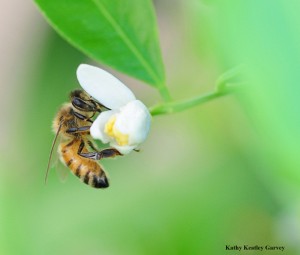by Kathy Keatley Garvey
UC Davis Dept. of Entomology and Nematology

UC Davis community ecologist Rachel Vannette has discovered why pollinators continue to forage on “toxic” or bitter-tasting nectar, despite what should be a deterrent.
In newly published research in the journal Ecology, Vannette noted that floral nectar is produced by many plants to reward pollinators, but this sugary secretion often contains chemical compounds that are bitter tasting or toxic, and can deter pollinators. Plants including citrus (Citrus), tobacco (Nicotiana), milkweed (Asclepias), turtlehead (Chelone), Catalpa, and others produce nectar containing bioactive compounds, including deterrent or toxic compounds.
“This poses a paradox of toxic nectar: why are deterrent or harmful compounds present in a resource intended to attract pollinators?” she asked. “One hypothesis is that these compounds reduce microbial growth, which could otherwise spoil the nectar resource.”
Vannette, an assistant professor in the UC Davis Department of Entomology and Nematology, and her colleague Tadashi Fukami, associate professor at Stanford University, tested this hypothesis by growing yeasts and bacteria in sugar solutions spiked with chemical compounds that are found in nectar.
“We examined effects on the growth of microbes isolated from nectar and non-nectar sources. Contrary to expectations, chemical compounds only weakly inhibited microbial growth in most cases. Interestingly, some microorganisms even grew better in the presence of plant compounds, like nicotine. But most surprising, we found that microbial growth in nectar reduced nectar toxicity, decreasing the concentration of chemical compounds in some nectar solutions.”
Microbial effects on nectar, in turn, increased consumption of nectar containing chemical compounds by honey bee pollinators, she said. “We found that microorganisms in nectar can both reduce the concentration of some plant compounds in nectar and increase consumption of nectar that does contain these compounds. This indicates that although ‘toxic nectar’ does not strongly inhibit microbial growth in nectar, microbes modify the palatability of nectar to pollinators, which can change foraging behaviors and may reduce selection on this trait in nectar.”
The paper, exploring the effects of nectar-inhabiting microbes on chemical compounds found in nectar and nectar consumption by pollinators, “demonstrates that the compounds in nectar—such as on citrus blossoms–do not inhibit microbial growth, Vannette said. “However, yeasts and bacteria that grow in nectar can modify the effects of plant chemical compounds on pollinator foraging and nectar consumption..”
In her abstract, Vannette wrote “Secondary metabolites that are present in floral nectar have been hypothesized to enhance specificity in plant-pollinator mutualism by reducing larceny by non-pollinators, including microorganisms that colonize nectar. However, few studies have tested this hypothesis. Using synthetic nectar, we conducted laboratory and field experiments to examine the effects of five chemical compounds found in nectar on the growth and metabolism of nectar-colonizing yeasts and bacteria, and the interactive effects of these compounds and nectar microbes on the consumption of nectar by pollinators.”
“In most cases, focal compounds inhibited microbial growth, but the extent of these effects depended on compound identity, concentration, and microbial species. Moreover, most compounds did not substantially decrease sugar metabolism by microbes, and microbes reduced the concentration of some compounds in nectar. Using artificial flowers in the field, we also found that the common nectar yeast Metschnikowia reukaufii altered nectar consumption by small floral visitors, but only in nectar containing catalpol. This effect was likely mediated by a mechanism independent of catalpol metabolism. Despite strong compound-specific effects on microbial growth, our results suggest that the secondary metabolites tested here are unlikely to be an effective general defense mechanism for preserving nectar sugars for pollinators. Instead, our results indicate that microbial colonization of nectar could reduce the concentration of secondary compounds in nectar and, in some cases, reduce deterrence to pollinators.”
The research, “Nectar Microbes Can Reduce Secondary Metabolites in Nectar and Alter Effects on Nectar Consumption by Pollinators,” appears on the Ecology website, http://onlinelibrary.wiley.com/doi/10.1890/15-0858.1/full
The research was funded by the Gordon and Betty Moore Foundation, the National Science Foundation, and Stanford University.
Future work will examine how microbial modification of nectar traits influences floral attractiveness, how microbial growth may modify the specificity of plant-pollinator interactions, and if microbial effects vary among plant species.
Vannette, a former postdoctoral fellow at Stanford University, joined the UC Davis Department of Entomology and Nematology in September 2015. “I am interested in understanding and predicting how microbial communities influence interactions between plants and insects,” she said. “In the Vannette lab (in Briggs Hall), we use tools and concepts from microbial ecology, chemical ecology, and community ecology to better understand the ecology and evolution of interactions among plants, microbes and insects.”